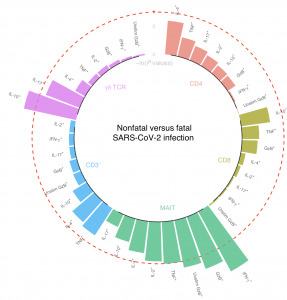
Circular bar plot represents negative natural logarithm P values of the frequency of immune cell (MAIT, CD8+, CD4+, CD3– and γδ T) function, including IL-2+, IL-4+, IL-10+, IL-17+, IFN-γ+, TNF+ and GzB+ after stimulation or GzB+ without stimulation (unstim), between deceased (stimulated, n = 6; unstimulated, n = 5) and surviving (stimulated, n =23, except for MAIT parameters, where n = 22; unstimulated, n = 16) patients infected with SARS-CoV-2. The red dashed circle represents a P value of 0.05. (Source: Flament et al., 2021)
The fatality and severity of coronavirus disease 2019 (COVID-19) are mainly due to immune system dysfunction. The key targets of SARS-CoV-2 are upper and lower respiratory tract cells and pulmonary cells that express angiotensin-converting enzyme -2(ACE-2) . The Innate-like T cells: mucosal-associated-Invariant T (MAIT), invariant natural killer T (iNKT), and γδ T cells are the primary defence force of pulmonary mucosal immunity. MAIT cells play an essential role by mucosal immunity by protecting against microbial infections. MAIT cell activation in response to viral infection is dependent on the cytokine microenvironment and independent of T cell antigen receptor (TCR).
In a recent study published in Nature Immunology researchers have studied the immune cell landscape with respect to the MAIT cells, in a total of 208 patients at various stages of COVID-19. Their findings suggest a relationship between the outcome of SARS-CoV-2 infection and MAIT cell activation/cytotoxicity. This study reveals some of the major MAIT cell alterations in SARS-CoV-2 patients which included:
- A decrease in circulating (blood) MAIT cell frequency
- COVID-19 disease severity was associated with highly activated MAITs cells that possessed increased effector and cytotoxic functions, which was showed to be also associated with potentially fatal outcomes in COVID-19.
- Association of MAIT cell activation with the concentration of proinflammatory cytokines and IL-10.
- The SARS-CoV-2 infected macrophages are able to induce cytotoxicity of MAIT cells.
- Progressive switching from type I interferon (IFN) in the blood to an IL-18 immune environment in the blood through a transcriptional switch.
In conclusion, the human MAIT cells are activated, showing cytotoxicity in the blood and lung of the patients with SARS-CoV-2. These MAIT cells could become an important biomarker and target for therapeutic approaches in severe SARS-CoV-2 disease.(Flament et al., 2021)
Journal Article: Flament et al., (2021). Outcome of SARS-CoV-2 infection is linked to MAIT cell activation and cytotoxicity. Nature Immunology
Summary by Ashutosh Tiwari










